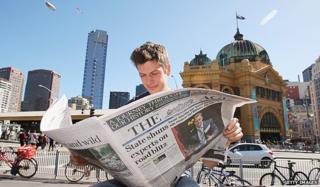
Australia ranks as one of the best countries to live in the world by international comparisons of wealth, education, health and quality of life. The sixth-largest country by land mass, its population is comparatively small with most people living around the eastern and south-eastern coastlines.
The country’s first inhabitants, the Aboriginal people, are believed to have migrated from Asia tens of thousands of years before the arrival of British settlers in 1788. They now make up less than 3% of Australia’s 23 million people.
Years of mass immigration after the Second World War heralded sweeping demographic changes, making modern Australia one of the world’s most multicultural countries. But migration continues to be a sensitive issue politically.
In shaping its foreign and economic policy, Australia first looked to Europe and the US but in the last 20 years has developed stronger ties with Asia. It has acted as peacekeeper in the region sending missions to Solomon Islands, East Timor and Papua New Guinea.
Although Australia remains part of the Commonwealth, the future role of the monarchy has been a recurring issue in politics. An aging population, pressure on infrastructure and environmental concerns such as climate change are some of the long-term challenges facing the country.
 Image copyright Martin Ollman/Getty Images Image caption Mr Morrison made his mark as immigration minister
Image copyright Martin Ollman/Getty Images Image caption Mr Morrison made his mark as immigration minister
Treasurer (finance minister) Scott Morrison emerged victorious from a week of governing Liberal Party infighting in August 2018 to succeed Malcolm Turnbull as leader of Australia’s main conservative party and prime minister.
The socially-liberal Mr Turnbull steered same-sex marriage among other measures through parliament after ousting his more conservative predecessor Tony Abbott in 2015, but his poor poll ratings spurred an unsuccessful right-wing challenge from Home Affairs Minister Peter Dutton.
The weakened prime minister bowed out a few days later, allowing the socially-conservative but pragmatic Treasurer Morrison time to unite the party ahead of elections in 2019.
As immigration minister under Tony Abbott in 2013-2014, Scott Morrison came to prominence for enforcing the policy of stopping boats run by people-smugglers from docking in Australia.
MEDIA
 Image copyright Getty Images Image caption Australia has a lively media scene and is considered to have a relatively free press
Image copyright Getty Images Image caption Australia has a lively media scene and is considered to have a relatively free press
Australia’s media scene is creatively, technologically and economically advanced. There is a traditoin of public broadcasting but privately-owned TV and radio enjoy the lion’s share of viewing and listening.
Ownership of print and broadcast media is highly concentrated, with two companies – The Murdoch-owned News Corp and Fairfax Media accounting for some 85 per cent of newspaper sales.
Around 19.5 million Australians are online.
Read a full media profile
TIMELINE
Some key dates in Australia’s history:
40,000 BC – The first Aborigines arrive from southeast Asia. By 20,000 BC they have spread throughout the mainland and Tasmania.
1770 – Captain James Cook charts the east coast in his ship HM Endeavour and claims it as a British possession, naming it “New South Wales”.
1901 – The Commonwealth of Australia comes into being.
1914 – Australia commits hundreds of thousands of troops to the British war effort during World War 1. Their participation in the Gallipoli campaign leads to heavy casualties.
 Image copyright Getty Images Image caption “White Australia” policies restricted non-white immigration in the first half of the 20th century
Image copyright Getty Images Image caption “White Australia” policies restricted non-white immigration in the first half of the 20th century
1948 – Australia launches a scheme for mass immigration from Europe.
2002 – In Bali, 88 Australians are among 202 people killed when bombs go off in two nightclubs.
2008 – Government makes a formal apology for past wrongs committed against the indigenous Aboriginal population.
Read a full timeline






